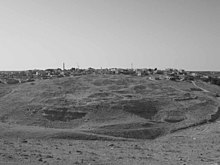m robot Adding:
nl:Dhiban |
No edit summary |
||
| Line 20: | Line 20: | ||
*Winnett, Fred and William Reed ''The Excavations at Dibon (Dhiban) in Moab: The First and Second Campaigns'' (1964). |
*Winnett, Fred and William Reed ''The Excavations at Dibon (Dhiban) in Moab: The First and Second Campaigns'' (1964). |
||
*{{Eastons}} |
*{{Eastons}} |
||
==External links== |
|||
* [http://www.fieldguidetojordan.com Field Guide to Jordan] |
|||
==Links== |
==Links== |
||
Revision as of 19:49, 14 September 2008

Dhiban is a modern town in Jordan, approximately 70 kilometers south of Amman and east of the Dead Sea. Previously nomadic, the modern community settled the town in the 1950s. Today, Dhiban is approximately 15000 members strong, with many working in the army, government agencies, or in seasonal agricultural production. A number of young people study in nearby universities in Karak, Madaba, and Amman. Most inhabitants belong to the Bani Hamida tribe and practice Islam.
Ancient Dhiban
The ancient settlement lies adjacent to the modern town. Excavations have revealed that the site was occupied intermittently over the past 5,000 years, its earliest occupation occurring in the Early Bronze Age in the third millennium BCE. The site's extensive settlement history is in part due to its location on the King's Highway, a major commercial route in antiquity.
The Israelites stopped at Dhiban during the Exodus. The Bible mentions "Divon" ( Hebrew: דִּיבֹן), or "Divon Gad" (דִּיבֹן גָּד) because the city was said to have been occupied by the Gad. The name in Biblical Hebrew means wasting or pining.
According to the Mesha Stele found at the site, Mesha, a Moabite king, expelled the Israelites and established ancient Dhiban as an important settlement in the kingdom of Moab.
Ancient Dhiban was also occupied in the Roman, Bzyantine, Early Islamic Umayyad, and Middle Islamic ( Mamluk) Period.
Sources
- Porter, Benjamin et al. “Tall Dhiban 2004 Pilot Season: Prospection, Preservation, and Planning.” Annual of the Department of Antiquities of Jordan 49 (2005): 201-216.
- Tushingham, A. Douglas The Excavations at Dibon (Dhiban) in Moab: The Third Campaign (1972).
- Winnett, Fred and William Reed The Excavations at Dibon (Dhiban) in Moab: The First and Second Campaigns (1964).
 This article incorporates text from a publication now in the
public domain:
Easton, Matthew George (1897).
Easton's Bible Dictionary (New and revised ed.). T. Nelson and Sons.
This article incorporates text from a publication now in the
public domain:
Easton, Matthew George (1897).
Easton's Bible Dictionary (New and revised ed.). T. Nelson and Sons. {{ cite encyclopedia}}: Missing or empty|title=( help)
External links
Links
Notes
31°30′N 35°47′E / 31.500°N 35.783°E
m robot Adding:
nl:Dhiban |
No edit summary |
||
| Line 20: | Line 20: | ||
*Winnett, Fred and William Reed ''The Excavations at Dibon (Dhiban) in Moab: The First and Second Campaigns'' (1964). |
*Winnett, Fred and William Reed ''The Excavations at Dibon (Dhiban) in Moab: The First and Second Campaigns'' (1964). |
||
*{{Eastons}} |
*{{Eastons}} |
||
==External links== |
|||
* [http://www.fieldguidetojordan.com Field Guide to Jordan] |
|||
==Links== |
==Links== |
||
Revision as of 19:49, 14 September 2008

Dhiban is a modern town in Jordan, approximately 70 kilometers south of Amman and east of the Dead Sea. Previously nomadic, the modern community settled the town in the 1950s. Today, Dhiban is approximately 15000 members strong, with many working in the army, government agencies, or in seasonal agricultural production. A number of young people study in nearby universities in Karak, Madaba, and Amman. Most inhabitants belong to the Bani Hamida tribe and practice Islam.
Ancient Dhiban
The ancient settlement lies adjacent to the modern town. Excavations have revealed that the site was occupied intermittently over the past 5,000 years, its earliest occupation occurring in the Early Bronze Age in the third millennium BCE. The site's extensive settlement history is in part due to its location on the King's Highway, a major commercial route in antiquity.
The Israelites stopped at Dhiban during the Exodus. The Bible mentions "Divon" ( Hebrew: דִּיבֹן), or "Divon Gad" (דִּיבֹן גָּד) because the city was said to have been occupied by the Gad. The name in Biblical Hebrew means wasting or pining.
According to the Mesha Stele found at the site, Mesha, a Moabite king, expelled the Israelites and established ancient Dhiban as an important settlement in the kingdom of Moab.
Ancient Dhiban was also occupied in the Roman, Bzyantine, Early Islamic Umayyad, and Middle Islamic ( Mamluk) Period.
Sources
- Porter, Benjamin et al. “Tall Dhiban 2004 Pilot Season: Prospection, Preservation, and Planning.” Annual of the Department of Antiquities of Jordan 49 (2005): 201-216.
- Tushingham, A. Douglas The Excavations at Dibon (Dhiban) in Moab: The Third Campaign (1972).
- Winnett, Fred and William Reed The Excavations at Dibon (Dhiban) in Moab: The First and Second Campaigns (1964).
 This article incorporates text from a publication now in the
public domain:
Easton, Matthew George (1897).
Easton's Bible Dictionary (New and revised ed.). T. Nelson and Sons.
This article incorporates text from a publication now in the
public domain:
Easton, Matthew George (1897).
Easton's Bible Dictionary (New and revised ed.). T. Nelson and Sons. {{ cite encyclopedia}}: Missing or empty|title=( help)
External links
Links
Notes
31°30′N 35°47′E / 31.500°N 35.783°E